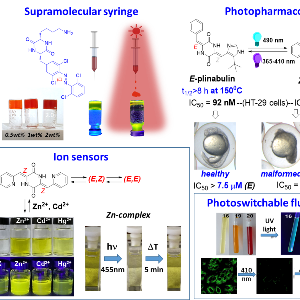
Dr. Zbigniew Pianowski, KIT
Invited by Dr. Evelyn Plötz, Prof. Don Lamb, Prof. Philip Tinnefeld
Molecular photoswitches convert the energy of light into reversible changes geometry and polarity, which may cause bioactivity changes, or macroscopic effects in materials.[1]
We have introduced biocompatible supramolecular hydrogels triggered with visible light,[2] and aminoacid receptors – all operational in water or aqueous buffers.[3]
We also discovered a novel class of peptide-derived molecular photoswitches – hemipiperazines.[4] One of them – plinabulin (a low-nM antimitotic agent) – undergoes activity photomodulation in vitro by two orders of magnitude,[4] and can be used to photocontrol development of zebrafish embryos.[5] Other hemipiperazines [6] can be used as photochromic metal ion sensors,[7] and photoswitchable fluorophores.[4]
[1] Z. Pianowski Chem. Eur. J. 2019, 25, 5128-5144; Z. Pianowski (Ed.) Molecular photoswitches. Chemistry, properties, and applications 2022, Wiley-VCH.
[2] A.-L. Leistner, M.M. Most, Z. Pianowski Chem. Eur. J. 2023, 29, e202302295.
[3] M.Most, L.Boll, P.Gödtel, Z.Pianowski, B.Lewandowski, Commun.Chem. 2025, 8, 50
[4] S. Kirchner, A.-L. Leistner, P. Gödtel, A. Seliwjorstow, S. Weber, J. Karcher, M. Nieger, Z. Pianowski Nat. Commun. 2022, 13, 6066.
[5] A. Seliwjorstow, et al. ChemBioChem 2024, 25(8), e202400143
[6] P. Gödtel, J. Starrett, Z. Pianowski Chem. Eur. J. 2023, 29, e202204009
[7] V. Schäfer, Z. Pianowski Chem. Eur. J. 2024, e202402005
